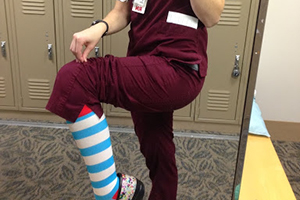
Let’s talk about the best compression socks for nurses…
Many professions require workers to be on their feet for long periods of time.
Especially in nursing.
Standing and walking for hours on end – sometimes up to 12 hours or more without any real-time to take a rest – can leave your legs and feet exhausted and swollen.
Not only that, but nurses who spend long hours on their feet can find that their circulation is inhibited because gravity is working against them.
This type of strain put on the legs can result in the pain and discomfort associated with varicose veins and spider veins.
Fortunately, the use of compression socks can bring some relief from pain, soreness and the risk of varicose veins associated with nursing.
Wearing compression socks can prevent blood pooling and encourages proper circulation around the feet, and it may also reduce swelling in the ankle area.
As a nurse, you’ll certainly want to shop for the best socks that can bring maximum relief from the issues likely brought about by standing. Before buying, you need to know about the best compression socks for nurses and others who are on their feet for many hours each day.
Compression Socks – What are they?
Before getting started talking about the best compression socks, we’ll first need to have a basic understanding of what compression socks are and how they should be used.
Compression socks are specially made stockings that stretch and fit snugly around the feet and legs. They may stop just below the knee or they may go up to the thigh. Originally, compression socks were only manufactured in basic colors such as white or black, but recently they’ve begun to come in all sorts of fun and fancy colors and styles to meet your personal preferences.
Graduated compression socks put the greatest amount of compression around the ankle but and then get a bit looser as they move up the leg. When such pressure is put on the legs it helps with blood circulation and prevents the swelling that can come from fluid pooling around the ankles (due to the pull of gravity). Compression socks help the circulatory system to fight against gravity to get the blood back up to the heart, which helps to avoid blood clots and other issues such as varicose veins. They work preventatively to keep some of these medical issues at bay, as well as therapeutically to reduce pain and discomfort.
What are they Used For?
Compression socks are used for a variety of medical conditions, including:
- Pregnancy-related swelling and vein problems
- Varicose or spider veins
- Lymphedema or edema
- Prevention of blood clots in the lower legs, known as DVT (Deep Vein Thrombosis)
- Poor circulation from sitting for long periods of time (travelers, pilots, etc.)
- Post-surgical and post-sclerotherapy treatment
- Relief for those who spend a significant amount of time on their feet to prevent swelling and/or the development of varicose veins or spider veins
Why Do Nurses and Healthcare Workers or Professionals Prefer Compression Socks?
Compression socks are used by nurses, people from other professions who are often on their feet, as well as people with various health issues that the socks can help with.
What are the best compression socks for nurses? Generally 20-30 mmHg Knee High Compression Socks that fit you correctly.
When people stand still for long periods of time, the forces of gravity increases the pressure placed on the veins of the legs.
The blood easily flows down from the heart into the body through the arteries but, as it attempts to move back up to the heart through the veins, gravity tends to create restrictions and difficulty.
This causes the veins to be under too much pressure which can eventually lead to compromised stability, resulting in varicose veins and spider veins. Wearing compression stockings aids the veins by giving them extra stability which can reduce pain and discomfort as well as preventing future occurrences of varicose veins.
Nurses aren’t known for standing still for more than, say, 5-seconds at most. (6-seconds or longer is considered a “legal break” for nurses). Still, if you’re on your feet for a long nursing shift, the effects are the same as standing. Swelling increases and compression socks (also known as “compression tubing for legs”) are practically a necessity.

People who don’t have a chance to elevate their feet throughout the day (Nurses!) may find that their ankles and feet tend to swell.
This pooling of fluids in the feet can sometimes be mitigated through the use of compression socks that keep the swelling down.
Here is a list of people who are advised to use compression socks regularly:
- People with limited circulation, blood pressure problems, varicose veins, DVT (Deep Vein Thrombosis), diabetes and many more are recommended the use of these compression socks by the medical community.
- Post-surgery patients may be prescribed the use of compression socks in order to speed recovery and prevent the formation of blood clots in patients who are immobile.
- People who are bedridden for various reasons (pregnancy, stroke, etc.) may need to wear compression socks in order to help with circulation and prevent blood clots. These patients use a special Anti-Embolism or T.E.D. Stocking.
- Nurses who have difficulty with dizziness upon standing up can wear compression socks to promote healthy circulation and relieve the distress of dizziness.
- When your profession requires you to stand for long hours, it is advisable to use compression socks.
- Sitting for long hours in one position can be part of some professions like pilots, those with desk jobs, etc. Wearing compression socks can help with better blood circulation and prevent some major health issues.
- Athletes who are prone to use their feet more or get swelling on their legs often can also use compression socks to get some relief.
- Pregnant women may find the use of compression socks helpful in reducing leg pain and preventing blood clots.
What Are its Features?
Compression socks come with a number of features that allow nurses to experience therapeutic benefits. Consider the following criteria when purchasing compression socks.
Things to note before buying a pair:
- The material used to make the socks needs to be made from durable and strong fabrics (look for nylon, polyester, and spandex).
- Socks for nurses should be made from fabrics that are breathable as well as stretchable.
- The compression socks need to offer pressure on the legs consistently without making the wearer feel uncomfortable. Materials such as elastane (Spandex), nylon, polyester, merino wool, LYCRA, and others are all soft and offer comfort.
- These socks should be available in different sizes and not follow the policy of one size fits all.
- Graduated compression that forces blood and fluid up from the ankle to the calf or thigh.
- An added advantage would be vibrant colors and patterns for a fun flair.
Compression Socks that are stretchy are usually made from a combination of Nylon and Elastane (aka “Spandex”). This helps the socks retain their flexibility and compressive properties.
Materials such as elastane (Spandex), nylon, polyester, merino wool, LYCRA, and others are all soft and offer comfort when used to make nurse compression socks. Apart from that, they do a great job of providing graduated compression which is the much-needed feature in nurses compression socks.
Don’t worry too much about the composition of your nursing compression socks, as long as they have the correct compression level and are fitted properly for your legs.
Fit is critical. The best compression socks are the ones that fit properly.
When compression socks have these features, you can be sure that they will offer the comfort and relief that you wish to have when wearing them.
What Are the Benefits of Using it?
When you understand what compression socks can do, you can certainly see the ways you might benefit from adding them to your life! Here are some of the main benefits found by nurses and others who use compression socks:
- With the use of compression socks, the feet will not get tired as easily, even if you stand for a long time.
- Your legs may feel less achy when you are on your feet for long hours at a time.
- The swelling in the legs, both feet, and ankles, may be minimized with the use of compression socks as they help your body to fight against the effects of gravity.
- Compression socks can bring major relief to people suffering from varicose veins and spider veins, reducing pain and discomfort as well as preventing the formation of others.
- Wearing compression socks may prevent some people from feeling dizzy and light-headed when they stand up.
- The use of compression socks may prevent the development of blood clots by helping the blood circulate properly and not letting it pool in one spot.
How to Select the Best Compression Socks Brand for Nurses
Here’s our choice of the best compression socks for nurses:
Selecting the appropriate compression socks can be a little tricky because there are a number of factors to consider. Quality and cost are the two major features that you may need to know about as you look into your compression socks brand.
Some brands do make quality goods but they come at a high cost. Some sell at a low cost but maybe are just cheap imitations and will not last long. So, find an in-between path where you get quality in a cost-effective manner. Buying online can be a great way to find affordable compression socks that are made in a quality manner. Always look for the best compression socks for edema.
Compression socks are available from a variety of manufacturers in different brands. They now come in various designs and colors – could be plain, with prints or themed.
Some compression socks are well-known and others may be new to the market. Well-known brands often cost more, but that doesn’t necessarily mean that they are better. Look for a brand that offers quality materials, top construction and a good value. Also, be wary of fly-by-night companies that make promises of miracles that aren’t realistic (such as One-Size-Fits-All).
What are its Different Kinds
Compression socks come in different sizes and types, each of which is made for different uses. There are even footless compression socks and toeless compression socks.
If you’re under the care of a doctor, compression socks can help you understand exactly what you need in the way of compression socks. A pharmacist is also a helpful resource in discovering what pressure and size of compression socks you might need.
Compression socks range from 8mmHg up to 40mmHg or even 50mmHg in some extreme cases. The measurement “mmHg” means Millimeters of Mercury and is the same measurement used in blood pressure cuffs.
Best Compression Socks for Nurses (and other professions that involve a lot of standing) are usually 20-30 mmHg.
Patients stuck in bed should use 10-20 mmHg Socks known as “TED Hose”.
If you’re simply using compression socks for daily use to help when you’re on your feet for long hours, your pharmacist might recommend using compression socks that come in the 20-30mmHg range. This is a mid-range sock that offers the greatest pressure (30mmHg) at the ankle and then lesser pressure (20mmHg) at the calf. This pressure typically works well for those trying to reduce fatigue, minimize swelling and prevent the risk of varicose veins and spider veins.
Can you sleep in compression socks? – No.
Are 20-30 mmHg Compression Socks appropriate for bed bound patients? – No.
Are 20-30 mmHg Compression Socks perfect for nurses? – Yes.
The best compression socks for nurses typically stop just below the knee as this provides them with snug support but doesn’t lend to being hot or uncomfortable.
However, compression socks are also available in a thigh-high or even pantyhose variety for those who prefer those options.
The only way to get the maximum possible benefit from compression socks is by wearing the right style, pressure type, and size. Don’t get something too loose like a TED Stocking (10-20 mmHg) and don’t get something too tight like Medical Compression Leggings (40+ mmHg)
If the pressure is too low or too high, or the size isn’t right, then you’ll not receive the health benefits you want and need from your compression socks.
Here are some other articles on the topic:
Best Compression Socks for Standing All Day
Which Compression Level is Right for You?
Compression stockings are medical-grade devices designed to move blood flow and, because of this, it is important that hospital compression socks are worn in the right size and with the correct pressure.
Support compression stockings are made available in multiple compression support levels. Most commonly, compression support stockings come in mild (8-15 mmHg), Medium (15-20 mmHg), Firm (20-30 mmHg), X-Firm (30-40 mmHg) gradient compression levels.
For nurses and others who are on their feet for a lot of time, the Firm pressure of 20-30 mmHg is often recommended by pharmacists and doctors to provide support. However, it is always helpful to check with your doctor or another medical professional to find out which pressure might be right for you.
There are many types of compression socks and stockings available without a prescription and they do offer wide-ranging benefits. Before wearing a compression therapy of 20 mmHg (Firm Compression) and above, it is generally recommended to consult your healthcare provider to find out if graduated compression stockings are right for you. If the answer is yes, they can tell you what pressure grade you should buy for maximum benefit and relief.
Guide to Measuring and Wearing Them
When trying to determine the size of compression socks or stockings you need, it is best to measure early in the day before swelling builds in the legs. Measurements taken later in the day after swelling occurs may cause you to choose an item that is too large and then not effective. When measuring, be sure to use the tape measure around the largest part of the ankle, the largest part of the calf, and from the lower part of the back of the knee down to the floor. Getting someone else to help you measure may be useful.
Compression therapy products are put on in the morning before getting out of bed, which is typically before any significant swelling could occur. The compression socks are then removed at night before getting into bed. Throughout the day the compression prevents blood from pooling in leg veins, prevents the development of varicose veins, helps your overall circulation and lessens or eliminates any leg swelling you may have.
There is NO one-size-fits-all!

As a side note, if you’re thinking about compression socks that claim “one size fits all”, then you may want to think again.
Although buying those compression socks might be less complicated because no measurements are required, it is important to understand that they simply cannot work as well as compression socks that are fitted to your personal size.
The best compression socks are like the best shirt or the best pants. They’re measured to fit your body.
There are women’s compression socks in 20-30 mmhg compression level in sizes ranging from Small to 3XL extra wide compression socks.
How to Wash Them
Knowing the correct method to keep your compression socks clean will allow you to use them for a long as possible.
Wash Compression socks after each use
Washing your nursing compression socks helps return the elasticity to its most effective level.
Since you need to wash each pair of nursing compression socks between wearings, you’ll likely want to have at least a couple of pairs.
When well cared for, a quality pair of compression socks can last several months.
Best to wash your compression socks according to manufacturer’s instructions:
– This usually entails hand washing and then hanging/laying flat to dry.
– Machine washing nurse compression socks can cause stretching. But generally it’s ok to gently wash compression socks in the washing machine. (Avoid hot water and use gently detergents only.)
– Tumble drying compression socks may contribute to shrinking. It’s best to hang dry your nursing compression socks. (Avoid wringing out socks because they can stretch.)
As a nurse, you can really benefit from compression socks.
They can reduce swelling, minimize fatigue, relieve symptoms of varicose veins, and generally provide you with a better experience while you’re on your feet.
And when you feel better, you can take more care to help your patients feel better too!
Check out the link below for our choice of the best compression socks for nurses
